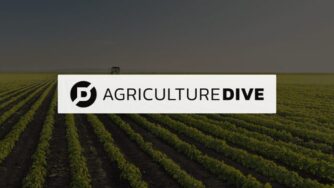Farmers operate within a complex system, with multiple components that affect the behavior and growth of plants. With so many factors in play, any change in how farmers manage their land can present multiple what-ifs.
The magic of models
In addition to this complexity, soil and environmental conditions vary from field to field, and even within a single field. Spatial variability of soil properties makes conventional soil sampling difficult to scale and transfer the results from one place to another. Samples need to be strategically selected in space with knowledge of the variability. But their true value increases exponentially when used with crop models.
Crop models have been around for four decades, although mostly in the academic research domain. With progress in agricultural science, computational power and greater availability of public datasets on soil and climate, they are finally being used to help stakeholders make more informed decisions.
Some models were developed to advance scientific knowledge and help provide answers and insights into complex mechanisms. These require many inputs that are not easily measurable, and thus must be estimated by users. Such estimation increases the uncertainties of results. Other models are based on readily available inputs with the goal of solving problems and supporting stakeholders in their decision-making.
Model balancing act
Models must have a balanced approach between the number and quality of input variables and the robustness in the simulation of complex processes and interactions. Unbalanced models tend to capture a high level of detail in some better-known processes, often neglecting details of less-understood processes of equal importance.
For example, it’s not helpful to have a detailed simulation of plant photosynthesis if the soil processes providing water and nutrients for the plant are not represented with the same level of detail. It’s not helpful to have a complex soil carbon model if it cannot reasonably simulate yields, root water and nutrient uptake. The quality results depend on the least-represented process simulated in the model. The appropriateness or fitness of the model depends on how well the results it delivers answer the questions being asked.
Further, models need to be validated across soil, climate and management conditions to build trust from the agricultural players who need them to scale results of practices to help adapt to and mitigate climate change.
One such model is SALUS. SALUS is a validated process-based crop simulation model that replicates systems interactions, processes and conditions of soil, with a plant grown on a computer, like a digital twin. Visual representations are tested or manipulated to scientifically assess what would happen in the real world if alternative options were implemented.
SALUS can reproduce soil and climate conditions and land management practices in space (locations within a field, landscape, region) and time (days, months, years).
Bringing SALUS to life in CIBO
CIBO created a digital platform that balances and integrates modeling intelligence with computer vision and image analysis, while remaining easy to use.
It can get results with high spatial granularity, even greater than field level, determining, for instance, what areas within the field have the highest crop yields and the most carbon-sequestering potential. It can determine which areas are low performing, and which agronomic practices can help increase profitability while building soil carbon and reducing nutrient losses to water and greenhouse gas emissions to the atmosphere.
Users can search online by farm, state or ZIP code to visualize maps of fields showing carbon sequestration potential and performance levels in specific areas. In addition, agricultural and food systems companies can search for carbon credits for sale to offset their emissions or create programs for their agricultural supply chains to incentivize, monitor, verify and report on regenerative, carbon-sequestering and GHG emissions reducing practices. Farmers can identify management practices to increase production and sustainability. Land investment funds can search for agriculture assets with the greatest yields and regenerative potential and reduced long-term environmental risk.
CIBO’s modeling technology is based on SALUS, System Approach for Land Use Sustainability.
In essence, farmers and other potential users in the agricultural sector can learn a crop’s footprint in an environment before that crop is even planted. That’s the true power of system-based modeling; farmers can reduce their risk of making costly and erroneous decisions — even with the best of intentions. They can go into their fields with more knowledge to minimize their risk with choices that can result in environmental and monetary payout (lower expenses through reduced input, reduced emissions and greater carbon credits). CIBO provides this intelligence because the model is built with science and knowledge translated into sound mathematical equations.
The SALUS model has undergone years of testing in 46 countries. It is widely used in public and private efforts globally to estimate food production and environmental sustainability.
CIBO is working with Verra, a globally trusted third-party carbon credit registry to ensure that their technology, processes that incorporate SALUS, and any carbon credits that result from their modeling, simulation, validation, and programs meet the highest standards demanded by carbon credit buyers around the world. Verra is a robust global standard for certifying carbon emission reductions.
Models help solve climate change
Through crop modeling, CIBO and the SALUS model simulate the growth of a plant on a computer by incorporating input such as weather, soil type, the plant’s genetics and agricultural management practices. The way a plant is managed can be changed on the screen to get answers to questions such as: “If I move from conventional tillage to no tillage (which does not disrupt soil) how much will my greenhouse gas emission be reduced?”; “If I grow a cover crop, how much carbon can I accrue?”; “How much rain infiltrates in the soil and how much is available to the plants vs. how much is lost by runoff before it infiltrates or by soil deep percolation?”
Simulating a given scenario before it happens not only helps with short- and mid-term decision-making but gives insight further out. We can change climate data and estimate future climate impact to predict yields and regenerative capacity as conditions change.
Additionally, while this model measures outcomes down to one field portion on one farm, it can look broader, assessing at county, region or national level. We believe this scaling capacity will help with our ultimate goal: advancing the transition to carbon sequestration practices in as many places as we can, as quickly as we can. We are committed, through system-based modeling, to expedite adoption of regenerative agricultural practices. We believe this approach — of bringing together well-proven and balanced modeling with AI-driven computer vision for practice identification and validation — will scale quickly to reduce carbon in the atmosphere and turn it into an asset under the ground.



